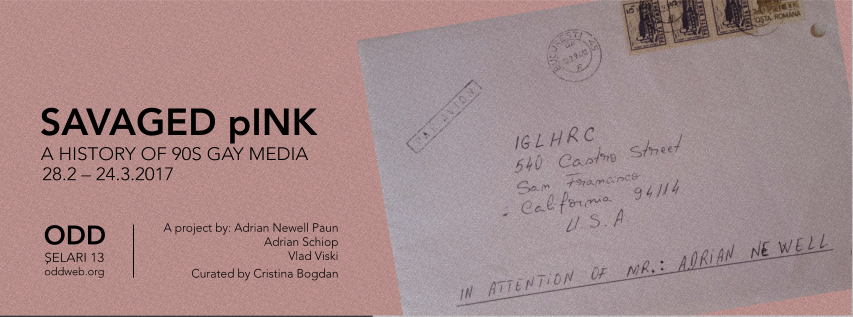SAVAGED pINK

SAVAGED pINK
A history of 90s gay media
A project by Adrian Newell Păun, Adrian Schiop, Vlad Viski
Curated by Cristina Bogdan
Opening 28.2.2017 19.00
Exhibition 28.2 – 24.3.2017
part of LGBT History Month
Using Adrian Newell Păun’s personal archive, the exhibition sheds light on different attempts to build a gay press in an era when homosexuality and “homosexual propaganda” were criminalized in the Penal Code. What were the main interests for gay people and how would they meet each other? What kind of public discourse developed around homosexuality? Which gay voices came forward and which ones disappeared? How did they express themselves? How do people cruise in the blurry space between the private and the public when private choices become the bedrock of a certain type of public discourse?
The exhibition does not claim to offer a complete history of homosexuality in Romania, not even one that is accurate. Various details get lost in the fogginess of those years. Scams, phoniness, lawlessness, con artists, all part of the larger picture, in an tumultuous post-revolutionary environment, both in society and in the media. The Golden Age of print media, with newspapers selling hundreds of thousands of copies throughout Romania. Soon information about gays started popping out. Letters to the editor, personals, boys looking for “long term friendship”, zealous reporters chasing the exotic, the illegal. In April 1993 Gay45, the first gay newspaper, sees light of day. The erotica media hosts generous information about homosexuals as well.
The press is also a means of communication, manipulated with great fantasy by those who cannot yet claim a public voice. In 1992, Adrian Păun places an ad in widely circulated local newspaper Evenimentul Zilei, announcing the creation of a gay pen club. The first public presentation of this archive of correspondence offers an exceptional insight into the private life of Romanian gays in those years.
Gay media continues its existence up until the early 2000s. Following the decriminalization of homosexuality in 2001, a wave of international sympathy towards Romanian gays translates into financial resources directed towards NGOs and a series of projects, both institutionally and privately. Newly started “glossy” gay magazines survive just as long as their subsidies, unable to compete on the free market. These new types of magazines underline an attempt to consolidate a local gay discourse, proposing a rather activist and at times inauthentic model. The story of the Romanian gay media continues online, with a series of blogs and websites, buried later on by the constantly expanding social media.
Poster design by George Roșu.